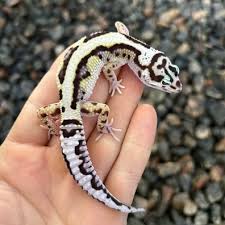GECKO GEM SNOW BOLD STRIPE (Eublepharis macularius)
$150.00
Full Description
Here’s a detailed care guide for the GEM Snow Bold Stripe Leopard Gecko (Eublepharis macularius), a beautiful morph that blends the crisp, pale coloration of GEM Snow with the striking dorsal pattern of Bold Stripe.
Overview
-
Common Name: GEM Snow Bold Stripe Leopard Gecko
-
Scientific Name: Eublepharis macularius
-
Morph Type:
-
GEM Snow – A dominant snow gene (similar but genetically distinct from Mack Snow)
-
Bold Stripe – Line-bred trait characterized by clean, bold lateral striping and reduced spotting down the back
-
-
Difficulty: Beginner to Intermediate
Morph Traits
| Trait | Description |
|---|---|
| Color | Pale, pastel base coloration (white to lavender) with bold lateral striping along flanks; minimal dorsal spotting |
| Pattern | Well-defined side stripes and sometimes a dorsal break; clean head markings typical of Bold Stripe lines |
| Genetics | GEM Snow = Dominant gene; Bold Stripe = Polygenic/line-bred |
| Size | 7–10 inches (adult) |
| Temperament | Docile, handleable, generally calm |
Enclosure Setup
Enclosure Size
-
Juveniles: 10–20 gal long
-
Adults: 20–40 gal breeder (36″ x 18″ recommended)
Substrate
-
✅ Safe: Reptile carpet, ceramic/slate tile, paper towels
-
Advanced: 70% organic topsoil + 30% play sand with clay (bioactive)
-
❌ Avoid: Calcium sand, loose wood shavings, coconut husk (impaction risks)
Hide Requirements
-
Warm hide (over heating zone)
-
Cool hide (opposite end)
-
Humid hide (for shedding) with sphagnum moss or moist paper towel
Decor
-
Rocks, branches, fake plants, low basking ledges
-
Encourage climbing and natural enrichment
️ Temperature & Humidity
| Zone | Temperature (°F) | Temperature (°C) |
|---|---|---|
| Warm side | 88–92°F | 31–33°C |
| Cool side | 75–80°F | 24–27°C |
| Nighttime min | 68–72°F | 20–22°C |
| Humidity | 30–40% ambient; 70–80% in humid hide |
Heating
-
Under-tank heater (UTH) on thermostat for belly heat
-
Optional: Low-wattage basking lamp with dimming thermostat
-
Ensure gecko has a gradient to self-regulate
Lighting
-
UVB not required, but 5–7% T5 UVB is beneficial for vitamin D3 production and bone health
-
Keep lighting indirect and low-intensity — especially important for stripe/snow morphs, which may be more light-sensitive
-
12-hour day/night cycle promotes natural behavior
️ Diet & Supplements
Insects (Gut-Loaded)
-
Crickets
-
Dubia roaches
-
Mealworms (in moderation)
-
Superworms (treat)
-
BSFL (excellent for calcium)
-
Waxworms (rare treat only)
Feeding Schedule
-
Juveniles: Daily
-
Adults: Every 2–3 days
Supplementation
| Type | Frequency |
|---|---|
| Calcium (no D3) | Always available |
| Calcium + D3 | 1–2× per week |
| Multivitamin | 1× per week |
Dust insects before each feeding.
Maintenance
-
Daily: Spot clean waste, refresh water
-
Weekly: Check humidity in humid hide, wipe surfaces
-
Monthly: Full clean or substrate change
-
If bioactive: Maintain microfauna (isopods/springtails) and moisture zones
Health & Shedding
| Sign of Health | Notes |
|---|---|
| Active at dusk | Naturally crepuscular |
| Clear eyes | No retained shed or cloudiness |
| Tail thickening | Indicator of fat reserves |
| Full shed every 3–4 weeks | Provide humidity support |
Handling Tips
-
Handle after 1–2 weeks of acclimation
-
Support entire body, avoid grabbing from above
-
Handle 2–3 times per week, 5–10 minutes per session
-
Avoid handling during shedding or right after feeding
✅ Summary Checklist
| Category | Requirement |
|---|---|
| Enclosure | 20–40 gal, horizontal space |
| Heat Source | UTH + thermostat |
| UVB (Optional) | 5–7% T5 linear or Arcadia |
| Substrate | Tile, reptile carpet, bioactive safe |
| Hides | Warm, cool, humid |
| Diet | Insects with supplements |
| Light Sensitivity | Moderate — avoid harsh lights |
| Morph-Specific | Keep pattern vibrant with moderate ambient light and low stress |

